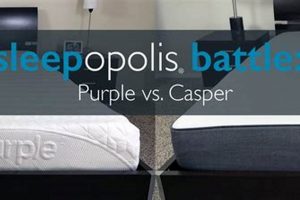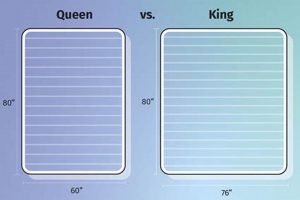Mattress dimensions differ significantly across continents. European standards, typically measured in centimeters, often vary from the inch-based systems prevalent in the United States. For example, a standard European double bed may have dimensions of 140cm x 200cm, while a US full-size mattress measures approximately 54 inches x 75 inches (137cm x 191cm). These variations impact bed frame compatibility and bedding selection.
Understanding these distinctions is crucial for international travelers, expatriates, and consumers purchasing mattresses or bedding online from overseas suppliers. Discrepancies in measurement can lead to ill-fitting sheets, inadequate frame support, and overall discomfort. Historically, these regional differences reflect varying cultural preferences, manufacturing standards, and material availability.
Therefore, a detailed exploration of specific size variations, nomenclature, and their implications for consumers is necessary. The following sections will examine common size designations, conversion charts, and factors contributing to these international discrepancies in mattress sizing.
When considering bedding solutions across continents, understanding the nuances of mattress dimensions is paramount to ensure comfort and proper fit. These tips address key considerations when dealing with differing standards.
Tip 1: Research Specific Dimensions: Before making a purchase, consult detailed dimension charts comparing mattress sizes in both European and American systems. These resources clarify the precise length and width in both centimeters and inches, preventing mismatches.
Tip 2: Account for Bed Frame Compatibility: Ensure the chosen mattress is compatible with the existing or intended bed frame. European frames are designed for metric sizes, while American frames adhere to inch-based measurements. Adapters or custom frames may be required.
Tip 3: Verify Sheet and Bedding Sizes: Standard bedding sizes differ between Europe and America. Purchase sheets and other bedding specifically designed for the mattress’s dimensions, regardless of the region of origin. Consider the mattress depth when purchasing fitted sheets.
Tip 4: Consider Mattress Depth: While length and width are critical, mattress depth, or thickness, also varies. Ensure that fitted sheets accommodate the mattress’s depth to prevent them from slipping off or being too tight.
Tip 5: Check conversion accuracy: If you need to convert between mattress dimensions, double-check the accuracy of the conversion using a reliable online tool or a precise measurement app.
Tip 6: Be aware of regional variations: Note that even within Europe, different countries may have their own slightly different standard mattress sizes. Always confirm the exact measurements for the specific country or region you’re purchasing from.
Tip 7: Opt for Adjustable Solutions: When uncertainty persists, consider adjustable bed frames or flexible bedding options that can accommodate minor variations in mattress sizes.
Careful attention to mattress dimensions is vital to avoid costly mistakes and ensure a comfortable sleep experience, especially when navigating between European and American standards. Verifying compatibility at each stage of the purchasing process can significantly improve satisfaction.
The subsequent sections will delve into specific examples of common discrepancies and provide practical solutions for addressing these challenges.
1. Nomenclature
Nomenclature, the system of naming conventions, plays a critical role in understanding dimensional differences between European and American mattresses. Inconsistencies in terminology can lead to confusion and purchasing errors, underscoring the need for clarity when navigating international bedding markets.
- Descriptive Terms
European and American markets use different descriptive terms for similar mattress sizes. For instance, what is termed a “double” mattress in Europe may correspond to a “full” mattress in the United States. Such terminological differences can mislead consumers who assume direct equivalency based on name alone. It becomes crucial to consult precise measurements rather than relying solely on the descriptive label.
- Size Categories
The classification of size categories, such as “single,” “twin,” “queen,” or “king,” does not hold consistent dimensional meaning across the Atlantic. A European “king” size mattress, for example, may differ substantially in width and length from an American “king” size. This disparity impacts bed frame compatibility and the fit of linens, necessitating careful verification of dimensions.
- Regional Variations
Nomenclature can exhibit regional variations even within Europe. Different European countries may employ unique terms or subtle dimensional nuances within the same size category. For example, while a standard “double” in one European country might measure 140cm x 200cm, another might deviate slightly. Understanding these intra-European differences is essential for avoiding errors when purchasing bedding from multiple sources.
- Implied Dimensions
The terms used often imply standard dimensions that may not align with actual measurements. A “super king” size mattress in the UK, for example, has a specific set of dimensions. However, without knowing those figures, one can’t be certain if the item will fit in one’s bedroom and on their bedframe. Therefore, it is crucial to get exact measurements to ensure it fits well.
These varied naming conventions emphasize the importance of focusing on precise dimensional data when comparing European and American mattresses. Terminology alone is insufficient for determining compatibility; meticulous attention to metric and imperial measurements is paramount to ensure satisfaction.
2. Centimeters vs. Inches
The distinction between centimeters and inches represents a foundational difference in measurement systems that significantly impacts mattress sizing between European and American standards. This divergence influences manufacturing, labeling, and consumer purchasing decisions, necessitating careful consideration when comparing bedding products across continents.
- Manufacturing Standards
European manufacturers adhere to the metric system, producing mattresses with dimensions specified in centimeters. Conversely, American manufacturers use the imperial system, with dimensions expressed in inches. This difference in fundamental units affects the precision and granularity of size variations. Metric measurements may offer finer distinctions than imperial measurements, influencing overall design and material usage.
- Dimensional Conversion Challenges
Converting between centimeters and inches introduces the potential for rounding errors and inaccuracies. While direct conversion formulas exist, small discrepancies can accumulate, leading to ill-fitting bedding or compatibility issues with bed frames. These challenges are particularly acute when dealing with mattresses near standard size thresholds, where minor rounding can shift a mattress into a different size category.
- Consumer Understanding
Consumers accustomed to one measurement system may struggle to visualize or compare mattress sizes expressed in the other. An American consumer may find it difficult to intuitively grasp the size of a 160cm x 200cm mattress, requiring a conversion to inches for meaningful comparison. This cognitive barrier can complicate online shopping and cross-border purchases, underscoring the need for clear and accessible conversion tools.
- Bed Frame Compatibility
Bed frames are typically designed to accommodate mattresses of specific dimensions based on either metric or imperial measurements. Attempting to fit a European mattress, sized in centimeters, into an American bed frame, designed for inches, often results in gaps or overhangs. This misalignment compromises support and aesthetics, emphasizing the importance of matching measurement systems when selecting both mattresses and bed frames.
The contrasting use of centimeters and inches creates a pervasive challenge in the context of mattress sizing. These issues lead to complexities in manufacturing, conversion, consumer understanding, and bed frame compatibility. Understanding these differences is essential for minimizing errors and ensuring satisfaction when purchasing mattresses across different regional standards.
3. Standard Single
The designation “standard single” mattress highlights a fundamental divergence within “european vs american mattress sizes”. This seemingly simple descriptor masks significant dimensional disparities, impacting everything from bed frame compatibility to bedding selection. In Europe, a “standard single” typically measures 90cm x 200cm. In the United States, the closest equivalent is a “twin,” which measures approximately 39 inches x 75 inches (99cm x 191cm). The size difference creates direct incompatibility. A European single mattress will not fit properly on an American twin bed frame, and vice-versa. Bedding designed for one will not fit the other.
The practical implications of this size difference are numerous. Consider a student moving from Europe to the United States for studies. The student cannot bring a European single mattress, as it will not fit standard American dorm room beds. Sheets, comforters, and other bedding purchased in Europe will be useless. Conversely, a traveler from the US to Europe will find the same issue, necessitating a purchase of new bedding at the destination. This underscores the importance of dimensional awareness in international contexts, particularly for individuals relocating or furnishing properties across continents.
The “standard single” example effectively illustrates the need for precise measurement and conversion when navigating mattress sizes. The simple name of this mattress type is not enough to accurately gauge it’s dimensions. This seemingly small difference between systems can lead to costly mistakes and inconveniences. Therefore, any comparison between American and European mattress sizes must start with verifying the dimensions of each mattress individually, no matter how common their name might be.
4. Double/Full Equivalence
The terms “double” and “full,” when applied to mattresses, exemplify a critical area of dimensional inconsistency within the context of differing European and American sizing standards. While often used interchangeably, these labels denote mattresses with significantly different dimensions, leading to potential fitment and comfort issues. A European “double” mattress commonly measures 140cm x 200cm, whereas an American “full” size mattress typically measures 54 inches x 75 inches (approximately 137cm x 191cm). The size variation creates a dilemma for consumers expecting direct equivalence. Purchasing bedding designed for a “double” mattress for use on an American “full” mattress, or vice-versa, will result in a poor fit. For example, fitted sheets designed for the larger European “double” will be loose and ill-fitting on the smaller American “full” mattress. The problem is made worse by differences in mattress depth.
The discrepancies in dimensions are rooted in historical manufacturing standards and regional preferences. European standards, developed with metric measurements, aim for specific size categories suited to the spatial requirements of European homes. American standards, based on the imperial system, evolved independently, resulting in different dimensions. This divergence becomes problematic in the age of globalization and online commerce. Consumers must be aware of the actual measurements in centimeters and inches, rather than relying solely on the double/full label. Cross-border transactions require verification of sizes to avoid purchase of incompatible products. Retailers that operate in both markets should emphasize precise measurements.
In summary, the perceived “Double/Full Equivalence” is a misnomer that masks significant dimensional differences. The practical implications extend to bedding compatibility, bed frame suitability, and overall consumer satisfaction. To avoid costly mistakes and ensure a proper fit, consumers should prioritize precise measurements and conversion data over reliance on standardized labels, particularly when purchasing mattresses or bedding across European and American markets. The complexity of mattress sizes is further increased by the lack of global sizing standards.
5. Queen/King Variations
The size designations “queen” and “king” exemplify a substantial disconnect between European and American mattress dimensions. These terms, while seemingly universal, represent significantly different measurements, impacting consumer purchasing decisions and bedding compatibility.
- Queen Size Discrepancies
In the United States, a queen-size mattress typically measures 60 inches x 80 inches (approximately 152cm x 203cm). In contrast, European queen sizes vary but often approximate 160cm x 200cm. This difference of several centimeters in width and length affects the fit of sheets and blankets. Bedding purchased under the assumption of a uniform “queen” size may be too tight or too loose, leading to discomfort and aesthetic issues.
- King Size Dimensional Differences
The American king-size mattress is typically 76 inches x 80 inches (approximately 193cm x 203cm), while a European king-size (often referred to as a “continental king”) can range around 180cm x 200cm. Some European countries may also offer a “super king” variant with even larger dimensions. The discrepancy necessitates careful attention when ordering mattresses and bedding online, especially from international retailers. Consumers must verify exact measurements rather than relying on the generalized “king” label.
- Bed Frame Incompatibility
Bed frames are designed to accommodate specific mattress dimensions. An American king-size bed frame will not properly fit a European continental king-size mattress due to width differences. This incompatibility can result in inadequate support and potential damage to both the mattress and the frame. Adapters or custom-made bed frames may be required to bridge the dimensional gap, adding to overall expense.
- Nomenclature Confusion
The use of “queen” and “king” labels across different regions creates a false sense of standardization. Consumers may assume a universal understanding of these terms, leading to misinformed purchasing decisions. Retailers bear a responsibility to provide clear and accurate dimensional information to mitigate confusion and prevent returns. Educational resources, such as conversion charts, can empower consumers to make informed choices.
In summation, the “Queen/King Variations” underscore the importance of verifying precise dimensions when dealing with “european vs american mattress sizes”. The terms are not interchangeable, and assuming equivalence can lead to costly errors. A focus on metric and imperial measurements is essential for navigating the complexities of international mattress sizing.
6. Depth Discrepancies
Mattress depth, or thickness, represents a significant, and often overlooked, dimensional variance between European and American standards. These “Depth Discrepancies” directly contribute to the complexities of “european vs american mattress sizes”, influencing bedding fit and overall sleep comfort. American mattresses often exhibit a wider range of depth variations, from thinner, low-profile models to significantly thicker “pillow-top” or specialty mattresses exceeding 14 inches (approximately 35 cm). European mattresses, while also varying, tend to adhere to a narrower range, typically between 15 cm and 25 cm. This difference originates in design preferences and construction techniques. American manufacturers frequently incorporate additional comfort layers, impacting overall thickness. Therefore, accurately measuring both the length, width, and depth of a mattress is important. A fitted sheet purchased according to length and width might not fit due to its sides being too short to cover the mattress. A consumer who is unaware of these dimension discrepancies is likely to mismanage this issue and purchase incorrect beddings.
The practical significance of understanding depth discrepancies lies primarily in bedding selection. Standard fitted sheets, designed for a specific depth range, may prove inadequate for mattresses exceeding those parameters. American consumers purchasing European mattresses, or vice-versa, must carefully consider mattress depth when selecting sheets, mattress protectors, and other bedding accessories. Failure to do so can result in fitted sheets that are either too tight, risking tearing, or too loose, creating discomfort and potential safety hazards. One may need to consult the specific measurements before making a purchase. Furthermore, the depth may influence bed frame choice. A very thick mattress might obscure the headboard, changing the bed’s aesthetics. The thickness of a mattress is therefore important to consider.
In conclusion, mattress depth is an indispensable component of dimensional considerations when comparing European and American standards. Overlooking these “Depth Discrepancies” can lead to mismatched bedding, compromised comfort, and unnecessary expense. By prioritizing accurate measurement and mindful product selection, consumers can navigate the complexities of “european vs american mattress sizes” and ensure optimal satisfaction with their sleep environment. Accurate measurement is essential for finding the correct size mattress.
7. Bedding Compatibility
The dimensional disparities between European and American mattresses directly impact bedding compatibility, creating significant challenges for consumers. “european vs american mattress sizes” influence not only the fit of sheets and blankets but also the overall comfort and aesthetic appeal of the sleep environment. Ill-fitting bedding, a direct consequence of size mismatches, can lead to discomfort, reduced sleep quality, and premature wear of linens. For example, a fitted sheet designed for a European queen-size mattress (typically 160cm x 200cm) will be too large and loose on an American queen-size mattress (152cm x 203cm), resulting in wrinkles, slippage, and a compromised sleeping surface. The reverse situation, attempting to fit American sheets on a larger European mattress, may result in tearing or the sheet simply not fitting over the mattress corners.
The importance of bedding compatibility extends beyond mere aesthetics. Properly fitting sheets contribute to hygiene and mattress protection. Loose sheets accumulate dust and allergens, compromising air quality and potentially exacerbating respiratory conditions. Conversely, overly tight sheets can compress mattress fibers, reducing their lifespan and comfort. Real-life examples abound in the online retail space, where consumers frequently express frustration with bedding purchased from overseas suppliers that fails to fit their existing mattresses. These experiences underscore the need for precise measurements and clearly labeled product specifications that account for both European and American sizing standards. Consumers should also be aware of elastic strength in the bedding they purchase, particularly for fitted sheets. Low-quality elastic may break or loosen over time, causing it to lose its ability to properly hold the sheet over the mattress. This is particularly true for thicker mattresses.
In summary, bedding compatibility is an essential component of the broader issue of “european vs american mattress sizes”. The dimensional discrepancies between these standards necessitate careful attention to detail when purchasing mattresses and linens. Retailers and manufacturers should provide comprehensive size charts and conversion tools to assist consumers in making informed decisions. A proactive approach to addressing these challenges will enhance customer satisfaction, reduce product returns, and promote a more comfortable and healthy sleep environment. Failure to recognize these dimensional discrepancies can lead to consumers unnecessarily buying a product that is wrong for them. This has led to some innovation, such as sheets with elastics running all the way around the edge of the fabric for a tighter fit.
Frequently Asked Questions
The following questions address common points of confusion regarding dimensional differences in mattress sizing between European and American standards.
Question 1: Are European and American mattress sizes directly interchangeable?
No, direct interchangeability is not possible due to fundamental differences in measurement systems (centimeters vs. inches) and standardized dimensions. Consumers must verify specific measurements to ensure compatibility.
Question 2: What is the closest American equivalent to a European “double” mattress?
The closest American equivalent is a “full” size mattress, but it is crucial to note that the dimensions are not identical. A European “double” is typically larger than an American “full”.
Question 3: Will European bedding fit an American mattress of the same named size (e.g., queen)?
Generally, no. Bedding is designed to correspond with the specific dimensions of mattresses within their respective regions. Mismatches can result in ill-fitting sheets and blankets.
Question 4: Where can accurate conversion charts for mattress sizes be found?
Reliable conversion charts are available on websites specializing in bedding, international shipping, and home furnishings. Cross-reference information from multiple sources to ensure accuracy.
Question 5: What factors contribute to the dimensional differences between European and American mattresses?
Historical manufacturing practices, differing cultural preferences, and variations in available materials contribute to these dimensional disparities. Standards evolved independently in each region.
Question 6: If purchasing a mattress online from a different continent, what precautions should be taken?
Thoroughly review the product specifications, paying close attention to metric and imperial measurements. Contact the retailer directly to clarify any uncertainties regarding size and compatibility. Also, consider the potential return costs if the size ends up not working.
Accurate measurement and a clear understanding of dimensional variations are essential to avoid purchasing errors and ensure comfortable and well-fitting bedding.
The next section will provide a comprehensive summary, reinforcing the key considerations when comparing European and American mattress sizes.
Conclusion
This exploration of “european vs american mattress sizes” underscores the critical need for precise dimensional awareness in the international marketplace. The discrepancies, stemming from differing measurement systems and manufacturing standards, extend beyond mere nomenclature. Bedding compatibility, bed frame suitability, and overall sleep comfort are directly impacted. Relying on assumed equivalencies based on size names can lead to costly errors and consumer dissatisfaction.
As global commerce expands, a commitment to transparent and accurate dimensional information becomes increasingly crucial. Manufacturers, retailers, and consumers must prioritize verified measurements and conversion data to navigate these complexities effectively. A continued focus on standardization efforts and enhanced consumer education will contribute to a more seamless and informed purchasing experience, mitigating the challenges posed by these dimensional differences. This commitment ensures appropriate sleep solutions are accessible across borders.







